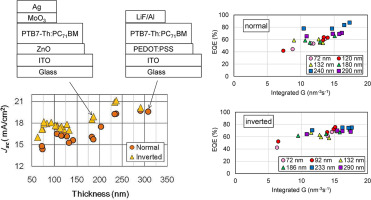Organic Electronics ( IF 2.7 ) Pub Date : 2017-09-11 , DOI: 10.1016/j.orgel.2017.09.006 Toshifumi Kobori , Takeshi Fukuda

|
In order to realize high performance of organic photovoltaic cells (OPVs), it is indispensable to optimize device structures according to composing materials. In particular, the optical density distribution in stacked layers is one of important factors to enhance the optical absorption within the photoactive layer, resulting in the improved photoconversion efficiency. In this study, we optimized the film thickness of the photoactive layer as a fundamental way to control the optical density distribution. The influence of the photoactive layer thickness on photovoltaic performances of OPVs was first investigated using, poly[4,8-bis(5-(2-ethylhexyl)thiophen-2-yl)benzo[1,2-b;4,5-b′]dithiophene-2,6diyl-alt-(4-(2-ethylhexyl)-3-uorothieno[3,4-b]thiophene-)-2-carboxylate-2-6-diyl)] and [6,6]-phenyl C71-butyric acid methyl ester blend films in normal and inverted OPV structures, respectively. The short circuit current density (Jsc) showed a peak at the thickness at around 100–120 nm and 80–100 nm in normal and inverted OPVs, respectively. In addition, Jsc of inverted OPVs were higher than those of normal OPVs for all the thicknesses. The FF decreased continuously with increasing the thickness in both device structures. The fill factor of normal OPV decreased with increasing thickness more slowly than that of the inverted OPV at the thickness of over than 200 nm. Furthermore, we simulated the optical density distribution in the stacked layers using the algorithm utilized matrix formulas based on Abeles's formulas. The simulated optical intensity distribution as a function of the position and the wavelength is in a good agreement with the experimental spectra of external quantum efficiency. The result indicates a close correspondence between the optical density distribution and the photovoltaic performance. At the optimum photoactive layer thickness of 116 nm in the normal and 76 nm in the inverted OPVs, we obtained the highest PCEs of 9.25 and 10.4%, respectively.
中文翻译:

光强分布对PTB7-Th:PC 71 BM基有机光伏电池器件性能的影响
为了实现有机光伏电池(OPV)的高性能,根据组成材料优化器件结构是必不可少的。特别地,堆叠层中的光密度分布是增强光敏层内的光吸收,从而导致提高的光转换效率的重要因素之一。在这项研究中,我们优化了光敏层的膜厚,将其作为控制光密度分布的基本方法。首先使用聚[4,8-双(5-(2-(乙基乙基己基)噻吩-2-基)苯并[1,2-b; 4,5- b'] dithiophene-2,6diyl-alt-(4-(2-ethylhexyl)-3-uorothieno [3,4-b]噻吩-)-2-羧化物-2-6-diyl)]和[6,6 ]-苯基C 71-丁酸甲酯混合膜,分别具有正向和反向OPV结构。短路电流密度(J sc)在正常和反向OPV中分别在100-120 nm和80-100 nm左右的厚度处出现一个峰值。另外,J sc所有厚度的倒置OPV均高于正常OPV。随着两个器件结构中厚度的增加,FF不断减小。当厚度超过200 nm时,正常OPV的填充因子随厚度的增加而降低的速度比倒置OPV的填充因子要慢得多。此外,我们使用了基于Abeles公式的矩阵公式,通过算法模拟了叠层中的光密度分布。作为位置和波长的函数的模拟光强度分布与外部量子效率的实验光谱非常吻合。结果表明光密度分布和光伏性能之间的紧密对应。











































 京公网安备 11010802027423号
京公网安备 11010802027423号